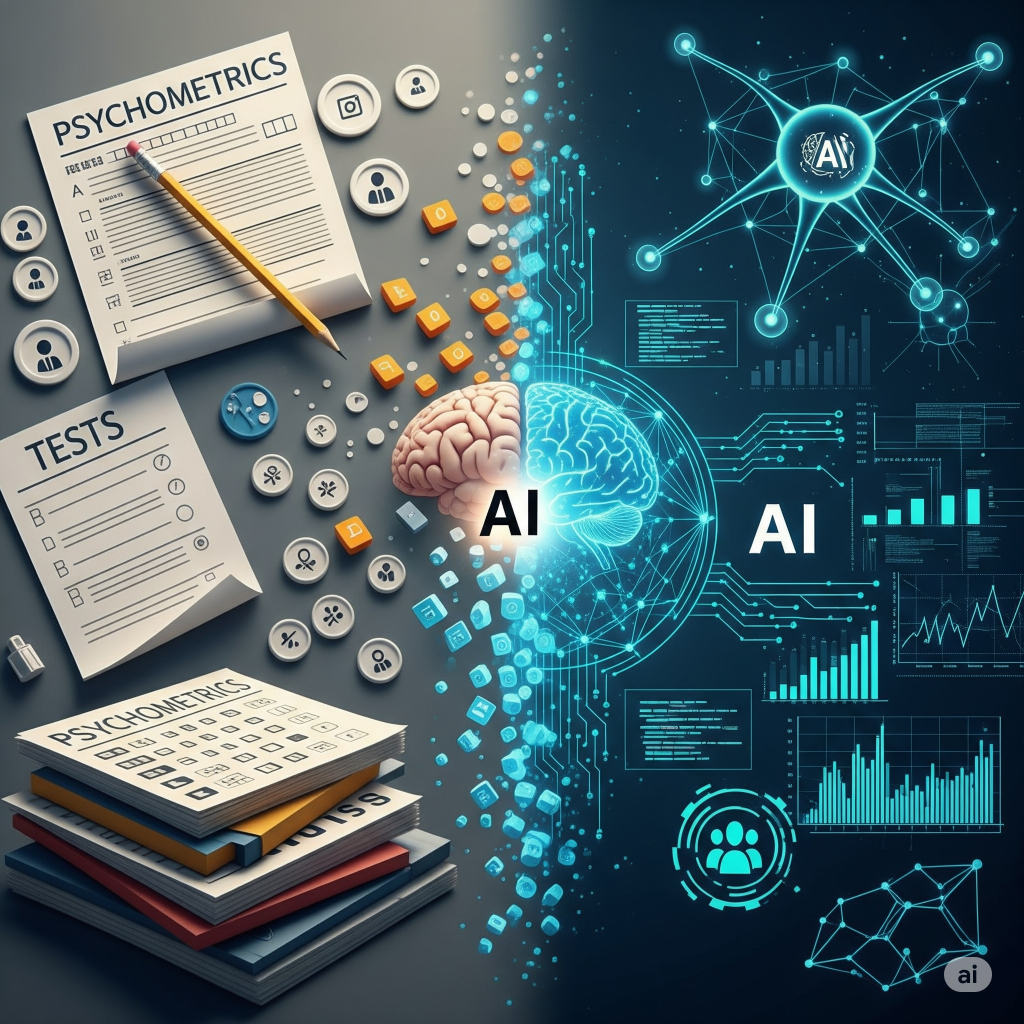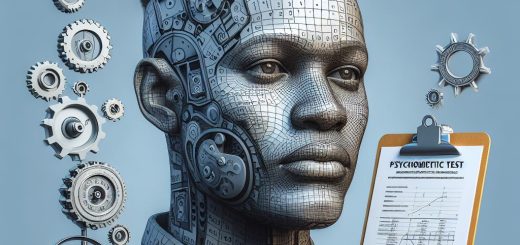The AI Psychologist: Synthesizing Psychometrics for Holistic Human Assessment
For decades, psychometric tests – measuring cognitive abilities, personality traits, motivations, and skills – have been cornerstones of talent acquisition, development, and clinical psychology. However, interpreting these diverse results often presents a challenge. Traditionally, human evaluators painstakingly review separate reports, attempting to weave together threads of aptitude, personality, and potential risk into a coherent narrative. This process is time-consuming, prone to human bias and fatigue, and struggles to capture the complex interplay between different psychological dimensions. Enter Artificial Intelligence (AI), promising a revolution in how we evaluate psychometric data to achieve truly holistic assessments.

The Fragmentation Problem
Imagine a candidate’s profile:
- Cognitive Ability Test: High abstract reasoning, moderate processing speed.
- Personality Test (e.g., Big 5): High Conscientiousness, Low Extraversion, Moderate Openness.
- Motivational Assessment: Strong drive for autonomy, low need for affiliation.
- Situational Judgment Test: Excellent analytical problem-solving, struggles with ambiguous interpersonal scenarios.
A human reviewer must mentally integrate these pieces. Does high conscientiousness compensate for moderate processing speed in a fast-paced role? Does low extraversion combined with low affiliation motivation signal a potential teamwork issue, or simply an introverted deep worker? How does high autonomy preference interact with the structure of the role? This synthesis is complex and subjective.
AI as the Integrative Engine
AI, particularly advanced machine learning (ML) and natural language processing (NLP), offers powerful tools to overcome fragmentation:
- Multi-Modal Data Fusion: AI algorithms excel at ingesting diverse data types – numerical scores, textual responses, patterns of response times, even audio/video data from assessments. It doesn’t see tests in isolation but as interconnected data streams.
- Pattern Recognition at Scale: AI can analyze vast datasets of historical assessments alongside outcomes (e.g., job performance, training success, therapeutic progress). It identifies subtle, non-linear patterns and correlations that humans might miss. For example, it might learn that a specific combination of moderate neuroticism, high empathy, and high resilience predicts success in high-stress client-facing roles, whereas any one trait alone is insufficient.
- Dynamic Weighting: AI models can dynamically weight the importance of different test results based on the context. For a research role, cognitive scores and openness might be heavily weighted. For a sales role, extraversion, agreeableness, and specific SJT responses might take precedence. The AI learns these weightings from data, not static rules.
- Predictive Modeling: By correlating psychometric profiles with known outcomes, AI can build predictive models. It doesn’t just describe the candidate; it predicts their potential fit for a role, likelihood of success in specific training programs, or even potential risk factors (e.g., burnout susceptibility based on personality and stress response patterns).
- Generating Narrative Insights: Modern NLP models can synthesize the complex data points into coherent, written summaries. Instead of listing scores, the AI can generate insights like: “Profile indicates strong analytical capability and deep focus, ideal for independent technical work. Potential challenges might arise in highly collaborative, ambiguous team environments requiring rapid social consensus building. High autonomy drive suggests a need for clear goals with flexibility in execution.”
- Identifying Paradoxes and Nuances: AI can flag seemingly contradictory results (e.g., high assertiveness on a personality test but low confidence scores on a specific skill assessment) and probe deeper, potentially prompting further exploration or interview questions.
Building the Holistic Picture: The AI Assessment Process
- Data Ingestion: AI ingests raw and interpreted data from all administered psychometric tests.
- Normalization & Calibration: Scores are normalized across different test providers and scales for fair comparison.
- Feature Engineering: Relevant features are extracted (e.g., specific sub-traits, response patterns, time metrics).
- Context Application: The model incorporates the assessment’s purpose (e.g., hiring for Role X, leadership potential, clinical diagnosis).
- Pattern Recognition & Integration: ML models identify complex relationships and interactions between cognitive abilities, personality traits, motivations, and skills within the given context.
- Prediction & Insight Generation: The model predicts relevant outcomes (fit, potential, risk) and uses NLP to generate a holistic narrative summary highlighting key strengths, potential development areas, risks, and contextualized insights.
- Human-AI Collaboration: The AI output is presented to the human professional (recruiter, psychologist, manager) not as a final verdict, but as a sophisticated, data-driven recommendation and synthesis tool to inform their final judgment.
Benefits of AI-Driven Holistic Psychometric Evaluation
- Deeper Insights: Uncovers complex interactions and predictive patterns invisible to manual review.
- Reduced Bias: Mitigates unconscious human biases (though requires careful algorithm design to avoid encoding new biases).
- Increased Efficiency: Dramatically speeds up the synthesis of complex assessment data.
- Enhanced Consistency: Applies the same rigorous analytical lens to every profile.
- Improved Predictive Power: Better forecasts of performance, fit, and development needs.
- Personalized Development: Enables highly tailored coaching and development plans based on the unique interplay of traits and abilities.
- Scalability: Makes sophisticated assessment accessible for larger volumes of candidates or employees.
Critical Considerations and Ethical Imperatives
The power of AI in psychometrics demands rigorous ethical safeguards:
- Algorithmic Bias: AI models trained on biased historical data will perpetuate and amplify biases. Constant auditing for fairness across demographics (gender, ethnicity, age) is non-negotiable.
- Transparency & Explainability (XAI): “Black box” algorithms are unacceptable. Professionals must understand why the AI reached its conclusions (e.g., which interactions were key?).
- Data Privacy & Security: Handling highly sensitive psychological data requires robust security and strict compliance with regulations (GDPR, HIPAA, etc.).
- Human Oversight: AI is an assistant, not a replacement. Final decisions, especially high-stakes ones, must involve qualified human judgment. The AI provides insights; the human provides context, empathy, and ethical responsibility.
- Validity & Reliability: AI models must be rigorously validated against real-world outcomes. Just because it’s AI doesn’t make it accurate.
- Informed Consent: Individuals must be clearly informed about how AI is used in their assessment and the implications.
The Future: Towards Truly Human Understanding
AI-driven holistic psychometric evaluation represents a paradigm shift. By moving beyond isolated scores to understand the dynamic system of an individual’s mind and capabilities, we gain a far richer and more predictive picture. This empowers organizations to make better hiring, development, and placement decisions, and clinicians to gain deeper diagnostic insights.
However, this future must be built responsibly. The goal is not to reduce humans to algorithms, but to leverage AI’s computational power to enhance human understanding and decision-making. When implemented ethically and transparently, AI becomes a powerful lens, bringing the intricate tapestry of human potential into sharper, more holistic focus. It allows us to see not just the individual threads of ability and personality, but the unique and valuable pattern they weave together.












